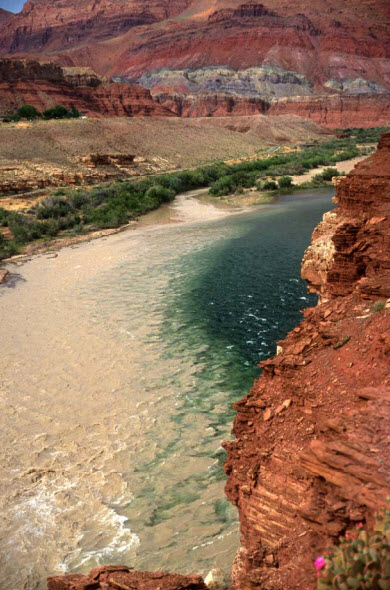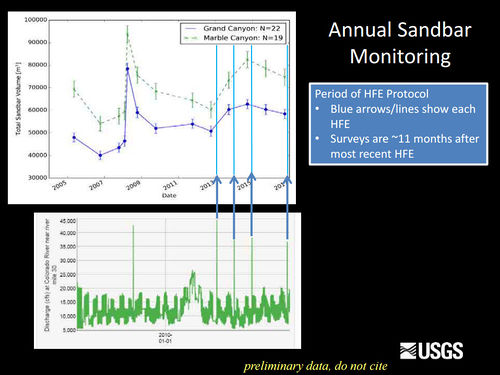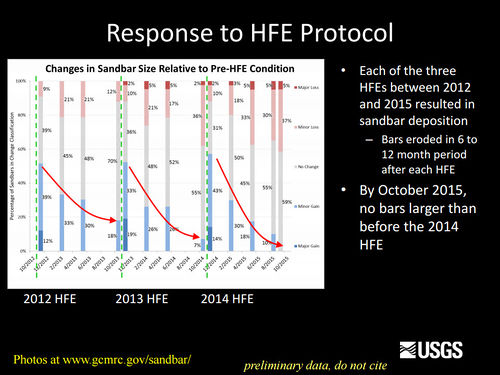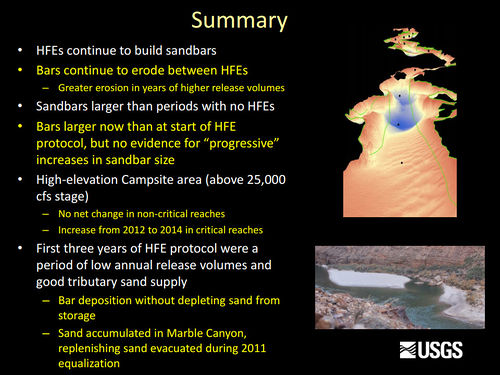Difference between revisions of "GCDAMP Sediment"
Cellsworth (Talk | contribs) |
Cellsworth (Talk | contribs) |
||
| Line 141: | Line 141: | ||
'''2017''' | '''2017''' | ||
*[[Media:Chapman 2017 Thesis-Determining tributary sediment exp flood deposits Marble Canyon ColRiv.pdf| Chapman, K., 2017, Determining the tributary sediment contribution to experimental flood deposits on the Colorado River in Marble Canyon, Grand Canyon, Arizona: Flagstaff, Northern Arizona University, MS thesis]] | *[[Media:Chapman 2017 Thesis-Determining tributary sediment exp flood deposits Marble Canyon ColRiv.pdf| Chapman, K., 2017, Determining the tributary sediment contribution to experimental flood deposits on the Colorado River in Marble Canyon, Grand Canyon, Arizona: Flagstaff, Northern Arizona University, MS thesis]] | ||
| − | *[https://digitalcommons.usu.edu/etd/6635 Hamill, D., 2017, Quantifying riverbed sediment using recreational-grade side scan sonar: Logan, Utah State University, MS thesis | + | *[https://digitalcommons.usu.edu/etd/6635 Hamill, D., 2017, Quantifying riverbed sediment using recreational-grade side scan sonar: Logan, Utah State University, MS thesis] |
| − | *[http://dx.doi.org/10.1002/2017JF004302 Buscombe et al., 2017, Compositional signatures in acoustic backscatter over vegetated and unvegetated mixed sand-gravel riverbeds: Journal of Geophysical Research: Earth Surface | + | *[http://dx.doi.org/10.1002/2017JF004302 Buscombe et al., 2017, Compositional signatures in acoustic backscatter over vegetated and unvegetated mixed sand-gravel riverbeds: Journal of Geophysical Research: Earth Surface] |
| − | *[https://doi.org/10.1016/j.geomorph.2017.08.037 Griffiths and Topping, 2017, Importance of measuring discharge and sediment transport in lesser tributaries when closing sediment budgets: Geomorphology | + | *[https://doi.org/10.1016/j.geomorph.2017.08.037 Griffiths and Topping, 2017, Importance of measuring discharge and sediment transport in lesser tributaries when closing sediment budgets: Geomorphology] |
| − | *[https://doi.org/10.3133/ofr20171030 Kaplinski et al. 2017. Channel mapping river miles 29–62 of the Colorado River in Grand Canyon National Park, Arizona, May 2009: U.S. Geological Survey Open-File Report 2017–1030 | + | *[https://doi.org/10.3133/ofr20171030 Kaplinski et al. 2017. Channel mapping river miles 29–62 of the Colorado River in Grand Canyon National Park, Arizona, May 2009: U.S. Geological Survey Open-File Report 2017–1030] |
*[https://www.usbr.gov/uc/rm/amp/twg/mtgs/17jan26/AR1_Topping.pdf Project 1: Streamflow, Water Quality, Sediment Transport, and Sand Budgets in the Colorado River Ecosystem ] | *[https://www.usbr.gov/uc/rm/amp/twg/mtgs/17jan26/AR1_Topping.pdf Project 1: Streamflow, Water Quality, Sediment Transport, and Sand Budgets in the Colorado River Ecosystem ] | ||
*[https://www.usbr.gov/uc/rm/amp/twg/mtgs/17jan26/AR2_Dean.pdf Project 2: Hydrologic Change and the Geomorphic Transformation of the Little Colorado River: Implications for Sediment Delivery to the Grand Canyon ] | *[https://www.usbr.gov/uc/rm/amp/twg/mtgs/17jan26/AR2_Dean.pdf Project 2: Hydrologic Change and the Geomorphic Transformation of the Little Colorado River: Implications for Sediment Delivery to the Grand Canyon ] | ||
| Line 150: | Line 150: | ||
'''2016''' | '''2016''' | ||
| − | *[https://pubs.er.usgs.gov/publication/pp1823 Topping et al. 2016. Long-term continuous acoustical suspended-sediment measurements in rivers — Theory, application, bias, and error: U.S. Geological Survey Professional Paper 1823 | + | *[https://pubs.er.usgs.gov/publication/pp1823 Topping et al. 2016. Long-term continuous acoustical suspended-sediment measurements in rivers — Theory, application, bias, and error: U.S. Geological Survey Professional Paper 1823] |
| − | *[http://pubs.usgs.gov/fs/2016/3053/fs20163053.pdf Voichick et al. 2016. Water clarity of the Colorado River—Implications for food webs and fish communities: U.S. Geological Survey Fact Sheet 2016–3053 | + | *[http://pubs.usgs.gov/fs/2016/3053/fs20163053.pdf Voichick et al. 2016. Water clarity of the Colorado River—Implications for food webs and fish communities: U.S. Geological Survey Fact Sheet 2016–3053] |
*[http://www.usbr.gov/uc/rm/amp/amwg/mtgs/16aug24/Attach_11a.pdf Sandbar Modeling Project Update] | *[http://www.usbr.gov/uc/rm/amp/amwg/mtgs/16aug24/Attach_11a.pdf Sandbar Modeling Project Update] | ||
*[http://www.usbr.gov/uc/rm/amp/amwg/mtgs/16aug24/Attach_07b.pdf Status of Sediment Resources – August 2016] | *[http://www.usbr.gov/uc/rm/amp/amwg/mtgs/16aug24/Attach_07b.pdf Status of Sediment Resources – August 2016] | ||
| Line 160: | Line 160: | ||
'''2015''' | '''2015''' | ||
| − | *[https://eos.org/features/building-sandbars-in-the-grand-canyon Grams et al. 2015. Building Sandbars in the Grand Canyon, EOS, Trans. Am. Geophys. Union | + | *[https://eos.org/features/building-sandbars-in-the-grand-canyon Grams et al. 2015. Building Sandbars in the Grand Canyon, EOS, Trans. Am. Geophys. Union] |
| − | *[http://repository.asu.edu/items/30069 Alvarez. 2015. Turbulence, Sediment Transport, Erosion, and Sandbar Beach Failure Processes in Grand Canyon. Ph.D. Dissertation, Arizona State University, Tempe, AZ | + | *[http://repository.asu.edu/items/30069 Alvarez. 2015. Turbulence, Sediment Transport, Erosion, and Sandbar Beach Failure Processes in Grand Canyon. Ph.D. Dissertation, Arizona State University, Tempe, AZ] |
*[https://drive.google.com/file/d/0BwY-Z2c3NTUGeUVIWEwyY1l6RUE/view GCMRC Science Update - Sediment] | *[https://drive.google.com/file/d/0BwY-Z2c3NTUGeUVIWEwyY1l6RUE/view GCMRC Science Update - Sediment] | ||
*[http://www.usbr.gov/uc/rm/amp/twg/mtgs/15jun11/Attach_02,.pdf GCMRC Science Update - Sediment] | *[http://www.usbr.gov/uc/rm/amp/twg/mtgs/15jun11/Attach_02,.pdf GCMRC Science Update - Sediment] | ||
| Line 214: | Line 214: | ||
'''2003''' | '''2003''' | ||
| − | *[https://pubs.usgs.gov/pp/pp1677/pdf/pp1677.pdf Topping et al. 2003. Computation and analysis of the instantaneous-discharge record for the Colorado River at Lees Ferry, Arizona, May 8, 1921 through September 30, 2000: U.S. Geological Survey Professional Paper 1677 | + | *[https://pubs.usgs.gov/pp/pp1677/pdf/pp1677.pdf Topping et al. 2003. Computation and analysis of the instantaneous-discharge record for the Colorado River at Lees Ferry, Arizona, May 8, 1921 through September 30, 2000: U.S. Geological Survey Professional Paper 1677] |
'''1988''' | '''1988''' | ||
Revision as of 11:18, 8 February 2018
|
|
Sediment and GeomorphologyErosion of sandbars (beaches) along the Colorado River in Grand Canyon was first reported in the early 1970s, approximately 10 years after completion of Glen Canyon Dam. Since then, scientific studies have been conducted to monitor changes in sandbars and changes in the amount of sand stored on the bed of the river. One of the outcomes of these studies has been the implementation of flow experiments intended to rebuild eroded sandbars, especially by the release of controlled floods, also called High Flow Experiments, or HFEs, from Glen Canyon Dam. The sediment and geomorphology projects at Grand Canyon Monitoring and Research Center include the collection and processing of data to provide information needed to conduct controlled floods and to evaluate the outcome of each controlled flood and the long-term effects of controlled floods and normal dam operations on sediment-related resources. [1] Beginning in 1998, recreational campsite area has also been measured on a subset of the sandbar monitoring sites. Campsite areas are defined as areas that are flat (less than 8 degree slope), smooth (not rocky), and clear of dense vegetation. Monitoring data show that vegetation expansion and sandbar erosion/deposition contribute to reductions in campsite area. LTEMP Resource Goal for SedimentIncrease and retain fine sediment volume, area, and distribution in the Glen, Marble, and Grand Canyon reaches above the elevation of the average base flow for ecological, cultural, and recreational purposes. Desired Future Condition for Sediment-Related ResourcesHigh elevation open riparian sediment deposits along the Colorado River in sufficient volume, area, and distribution so as to provide habitat to sustain native biota and desired ecosystem processes |
| --- |
--- |
--- |
|---|



